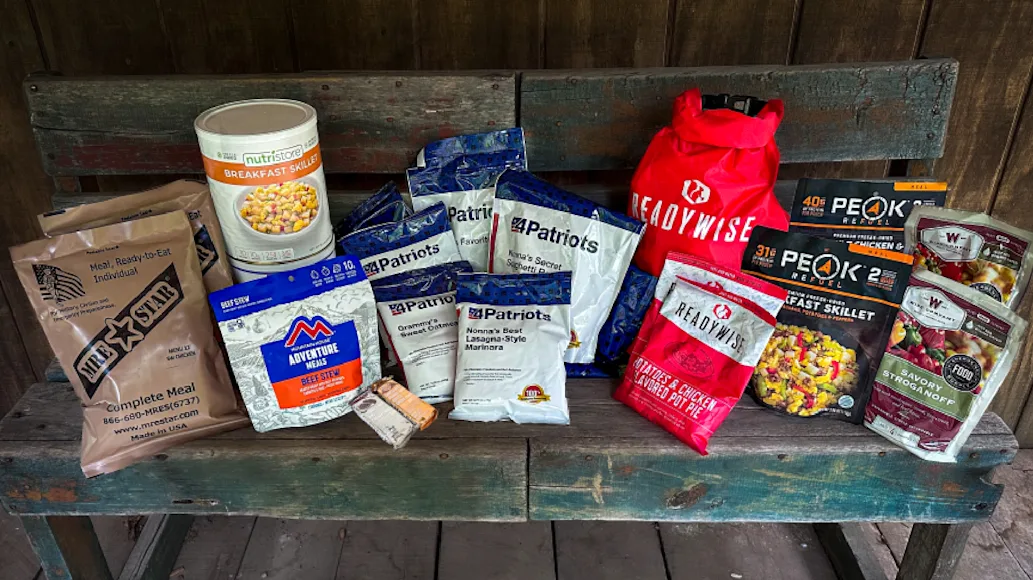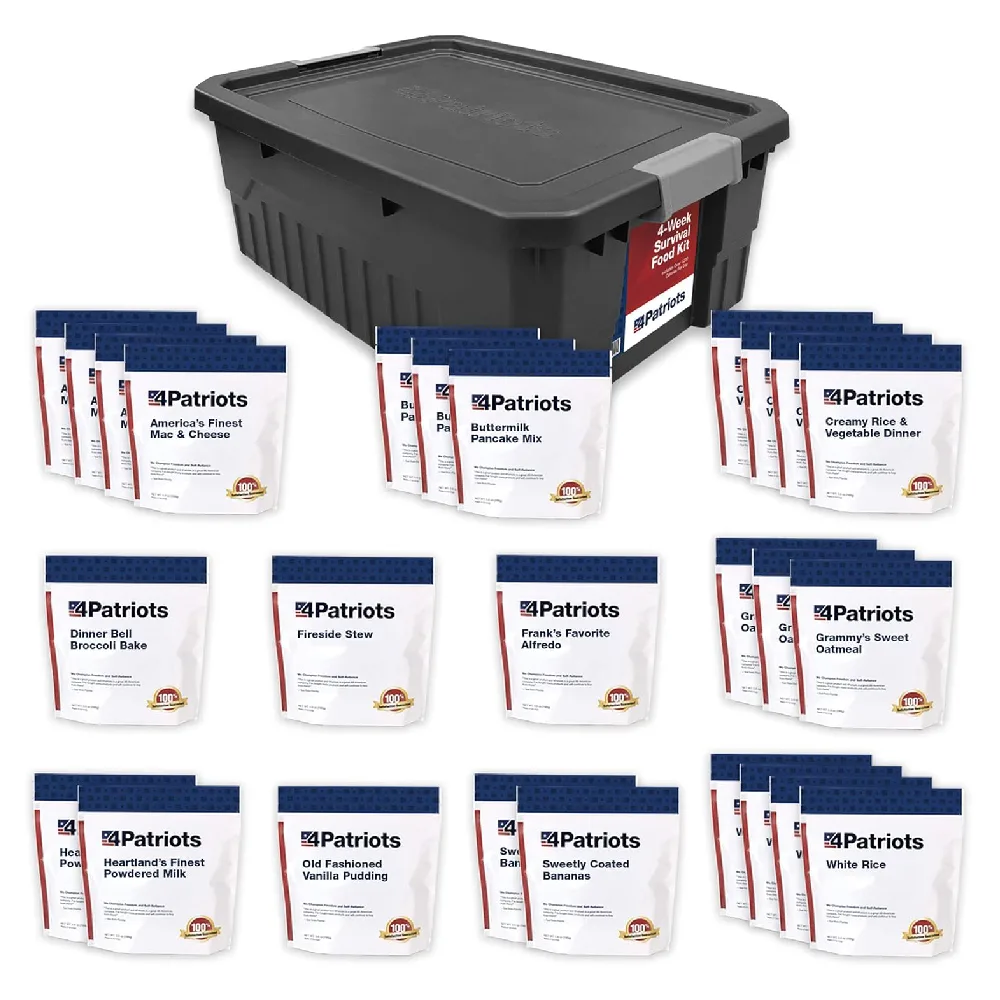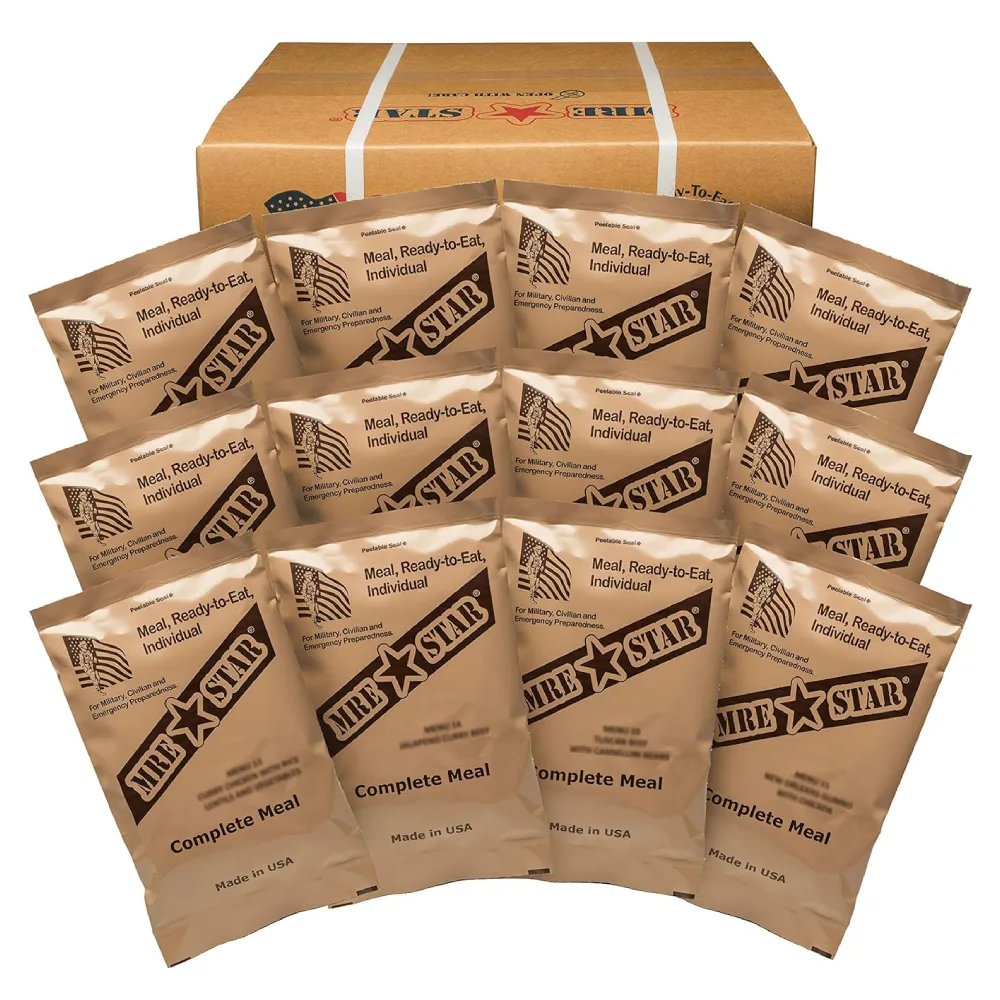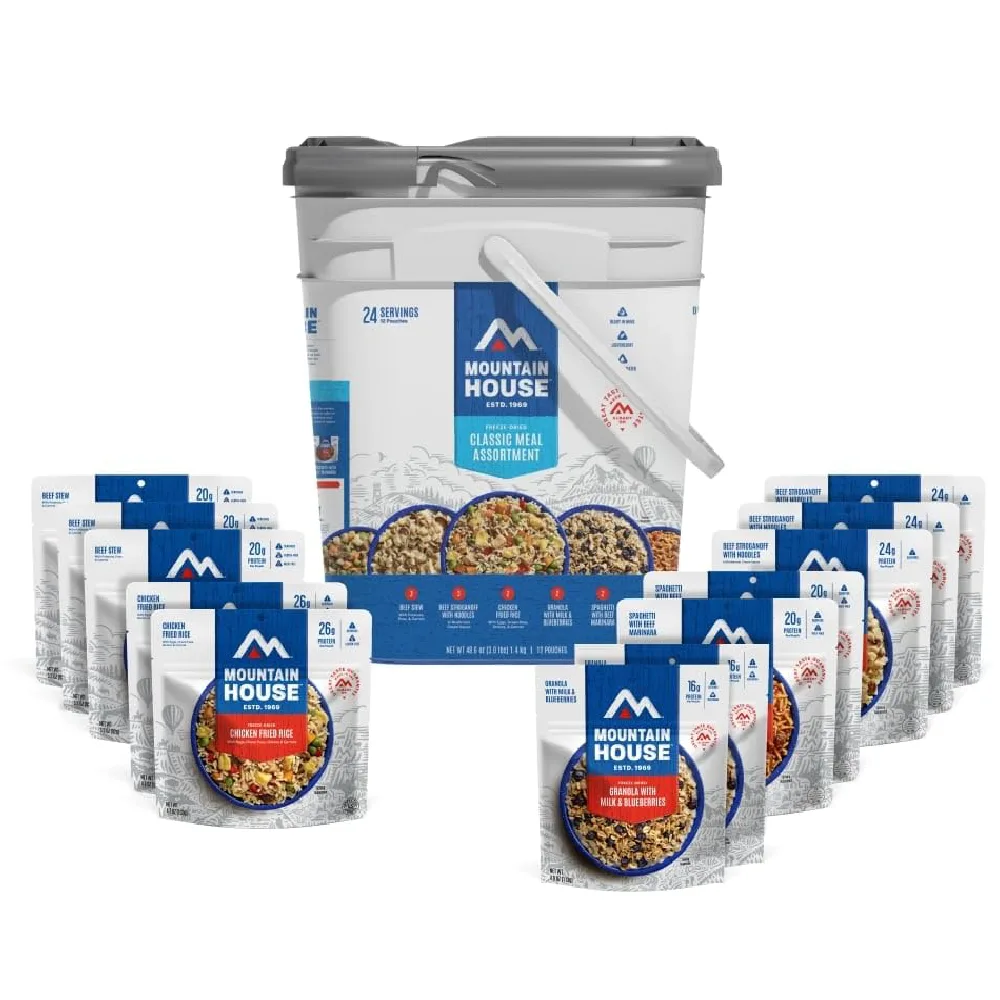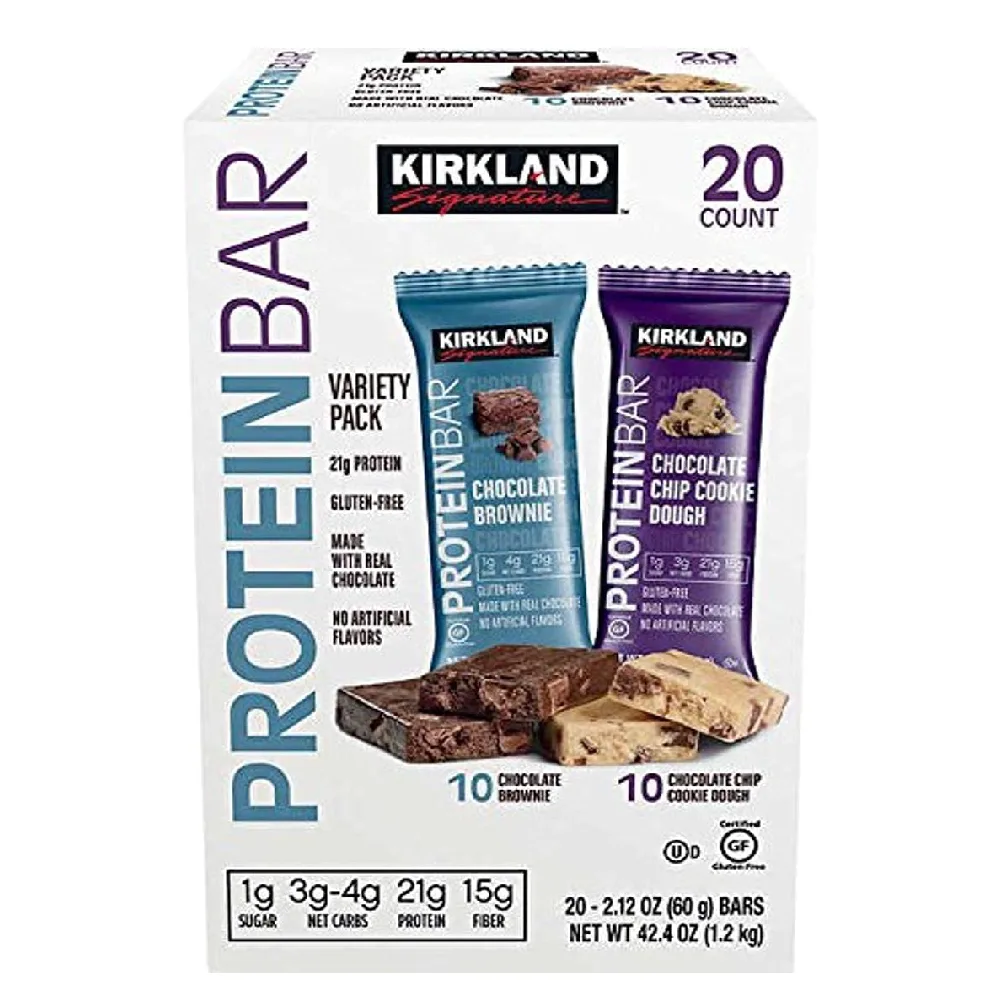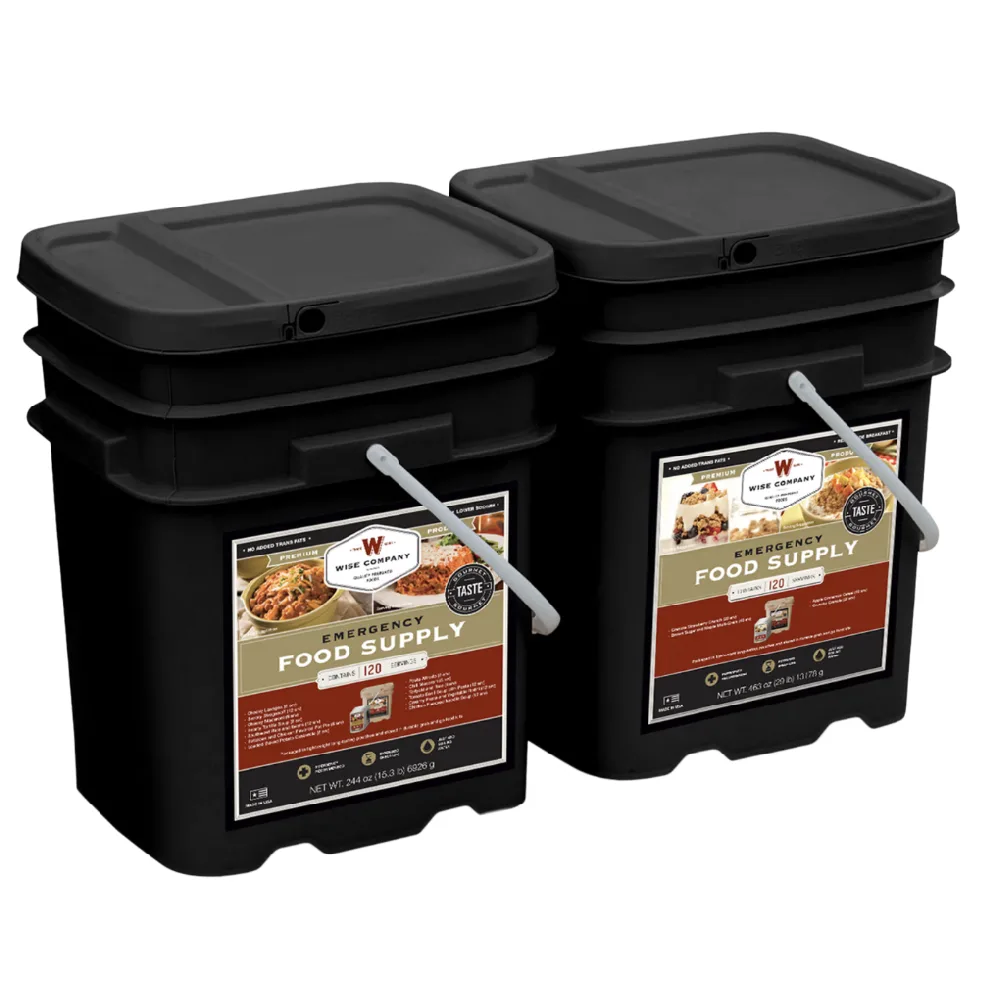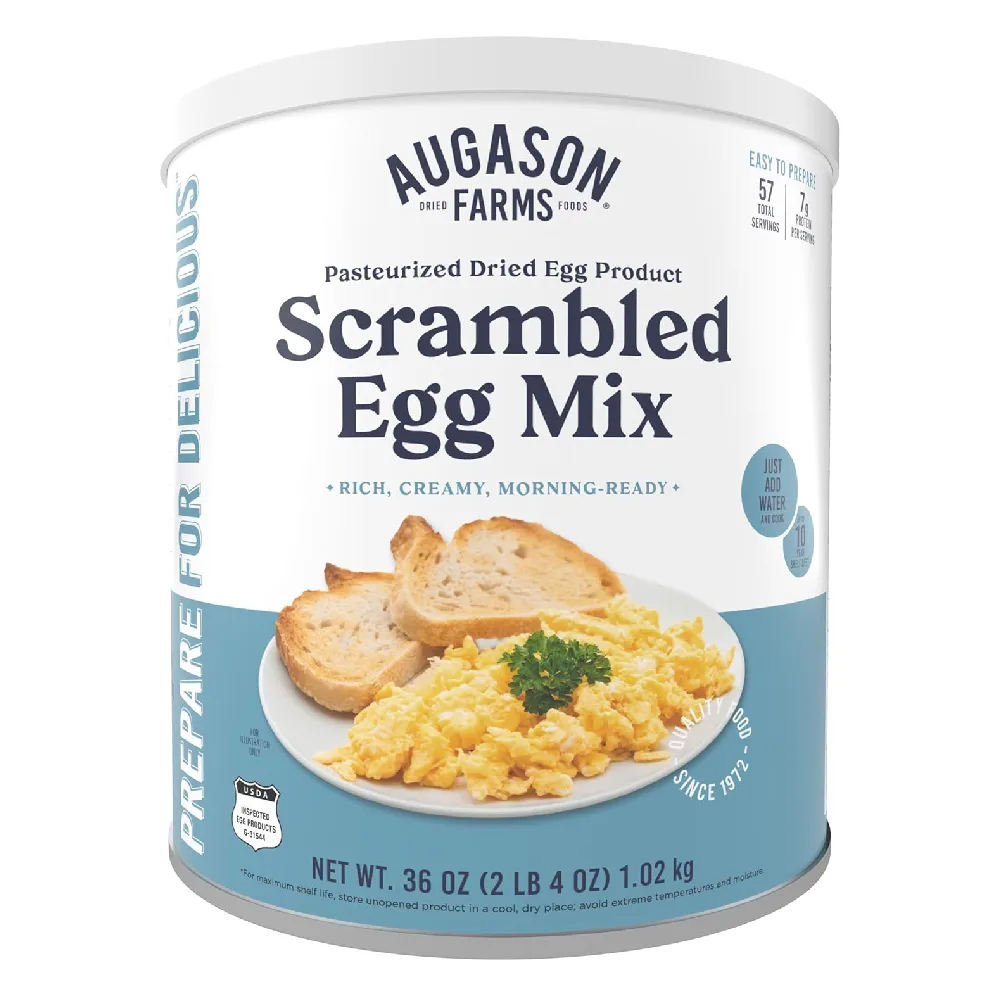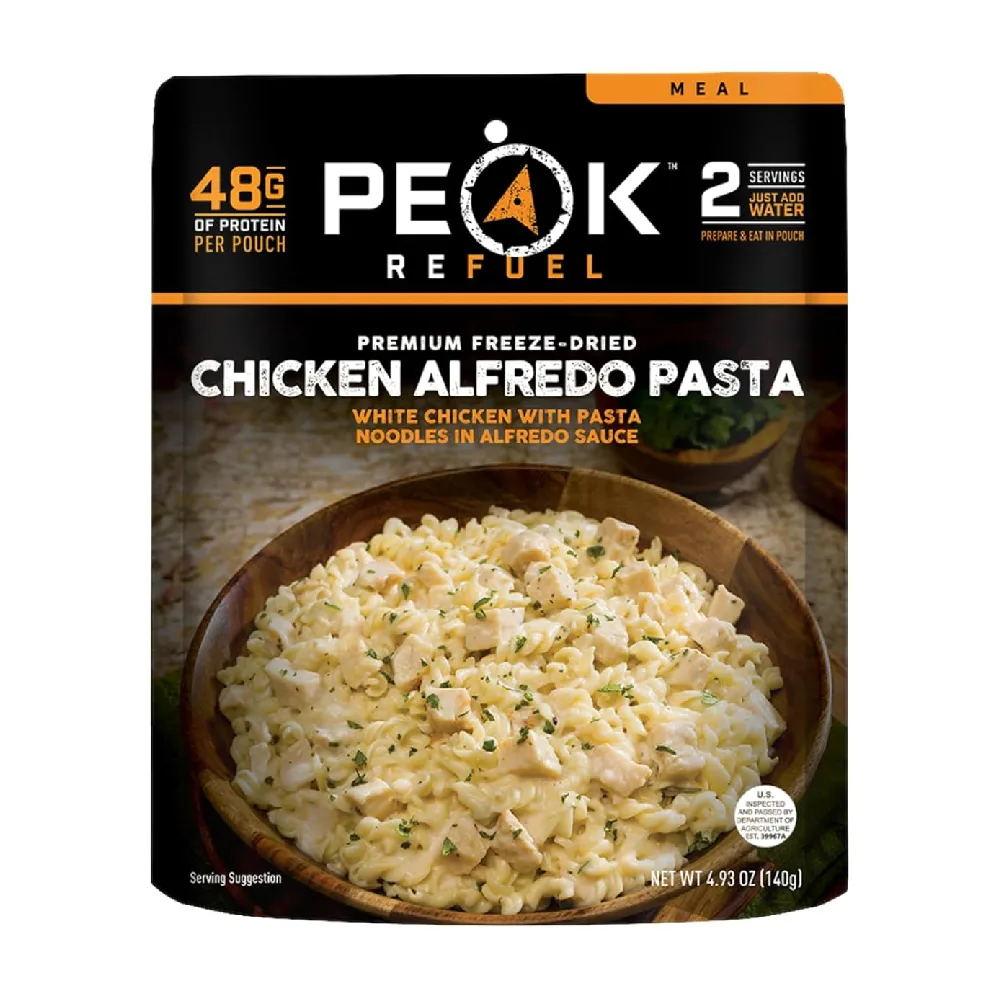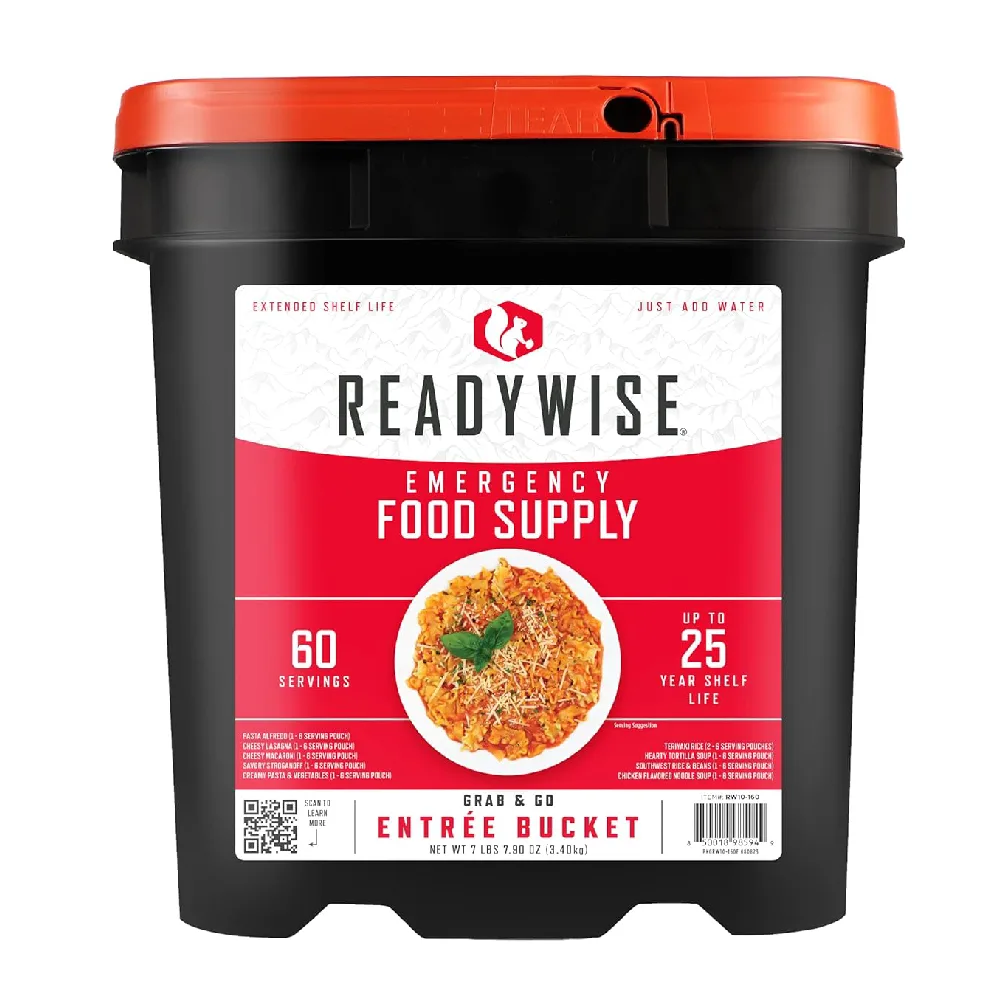We may earn revenue from the products available on this page and participate in affiliate programs. Learn more ›
Regarding survival, a reliable food supply is high on the list of needs for disaster readiness. A well-rounded, easy-to-transport kit that keeps you nourished for days—without repeating the same bland meals—is crucial for morale and sustenance. Many survival food companies are on the market, but not all have stood the test of time. Over the years, several have failed due to poor quality control and mismanagement. As a disaster readiness and survival training professional, I receive samples from many of these companies and, more importantly, have the unique opportunity to have hundreds of students test their products yearly. Additionally, I bring these samples to our courses to gather feedback from our instructors and participants. The insights shared in this article are based on decades of personal experience and the collective input of our students, providing you with a well-rounded perspective to help you make informed decisions about your food preparedness.
At the end of the day, no matter the crisis, we all need food to keep us going. While it’s true that humans can survive for weeks without eating, very few would willingly test that theory. The good news is that with the growing demand, more high-quality, nutrient-dense options are now available. After testing some of the best survival food on the market, these are our top picks for flavor, shelf life, and nutrition.
Best Overall: 4Patriots Survival Food Kit
Best Short Term: MRE Star Kit
Best Long Term: Mountain House Adventure Meals Classic Bucket
Best Food Bars: Kirkland Protein Bars
Best Food Kit: Wise Company 1-Month Emergency Food Supply
Best Canned: Augason Farms
Best Freeze-Dried: Peak Refuel
Best Budget: ReadyWise Emergency Food Supply
Best Overall: 4Patriots Survival Food Kit
Specs
Shelf Life: 25 years
Pros
Wide variety of food, including meals, fruits, and desserts
Quick and easy to make
Mylar packaging keeps food fresh for longer
Kits have discreet carry methods
Top in several categories, including total, long-term, and package kits
Many other survival supplies available that integrate with their food choices
Cons
Difficult to cook in quick-boil systems; boil slowly in everyday cookware.
4Patriots has established itself as one of the leading survival food brands in the market. Proudly made and packaged in the United States, their products support local businesses while delivering high-quality meals. These meals are crafted for superior nutrition and taste, using fresh ingredients and whole grains, and are free from MSG. Preparation is simple—boil water, add the pouch, and within 15 minutes, you'll have a hot meal ready to eat.
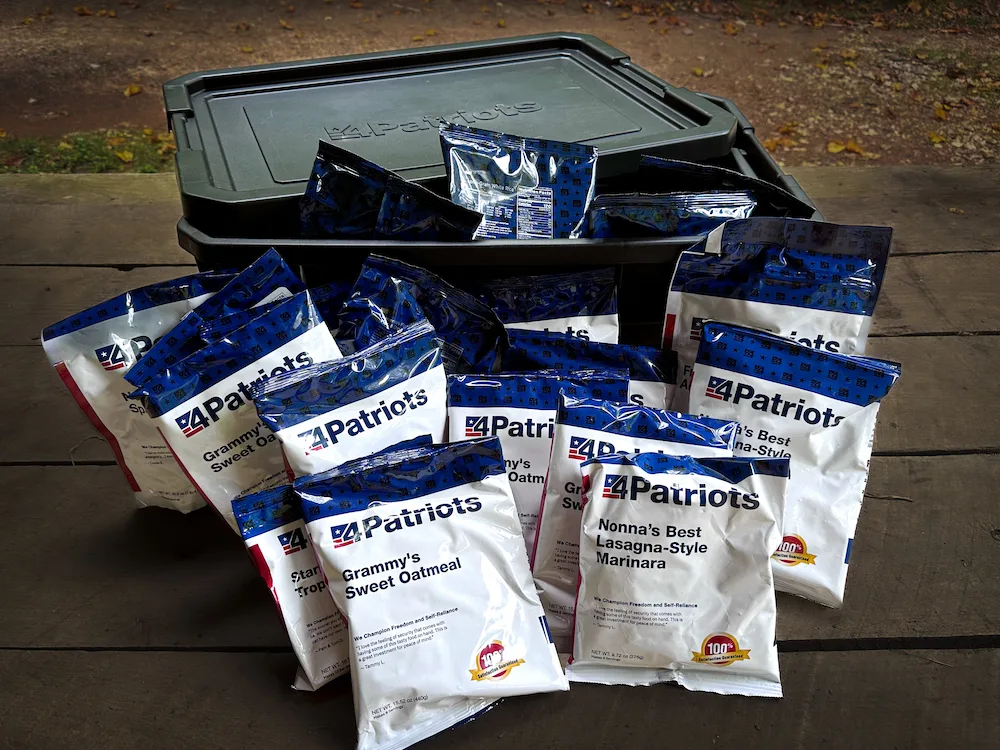
4Patriots package their food in triple-layer Mylar to ensure long shelf life, which helps protect the contents from air and moisture. Customers can select from various kit sizes depending on their needs, from 72-hour emergency supplies to year-long provisions. Each kit is designed to provide one person with six servings a day, offering sufficient calories and nutrients to sustain energy. The meals come in various flavors, including macaroni and cheese, vegetable soup, and oatmeal. One of my favorite pieces of their kits is that many of the meals are named after people to add some morale build into it all. No matter the kit size, 4Patriots offers a reliable solution for building a robust survival food supply.
Best Short Term: MRE Star Kit
Specs
Shelf Life: 3 to 5 years
Pros
Full ready-to-eat meal in every pouch
Complete but separate meal components in one package
Added seasonings and flavorings
Easy to store and use
Calorie-dense food
Can be eaten hot or cold
Cons
Can cause digestive upset in some people
Each MRE pouch is a complete meal kit containing everything you need to stay nourished, making it our top choice for short-term survival food. Inside, you'll find various items, including candy, coffee, a drink mix (typically fruit-flavored), utensils, a napkin, a wet nap, sugar, salt, pepper, and hot sauce. Additionally, each meal provides a main entrée, starch (such as crackers or tortillas), a snack (like corn nuts, a nut and raisin mix, or dried fruit), and a dessert (cookies or another sweet option).
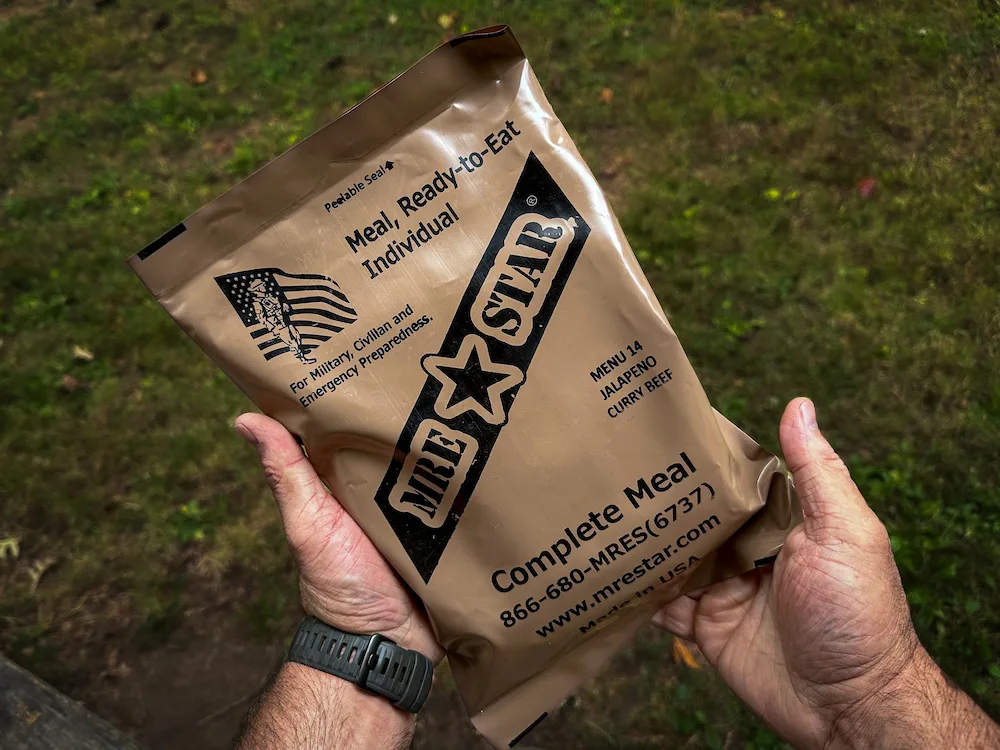
A vital feature of an MRE is the built-in heater, which, once activated, heats your entrée, providing the convenience of a hot meal no matter where you are. However, there are some notable downsides. Many of our students, particularly those with military experience who have relied on MREs for extended periods, advise against using them for long-term situations. In addition to being heavy to transport, they can lead to digestive problems, ranging from constipation to more organ-related severe issues over time.
Best Long Term: Mountain House Adventure Meals Classic Bucket
Specs
Shelf Life: 30 years
Pros
30-year taste guarantee
Fix in the pouch convenience
Hot meals almost with boiled water
No artificial colors or flavors
Over two dozen varieties to choose from
Cons
High levels of sodium in many choices
Providing a hot meal for your family during a disaster is more than just a practical necessity—it can help boost morale and alleviate anxiety, offering a sense of normalcy amidst the chaos. Mountain House meals taste delicious and require boiling water for preparation. Mountain House is a regular staple of meal choices in our classes. I see them often.
One of the great features is that the food rehydrates directly in the pouch, allowing you to eat from it, which means minimal cleanup afterward. With nearly 30 meal options, including breakfasts and desserts, variety won’t be an issue, and no one will find the meals repetitive.
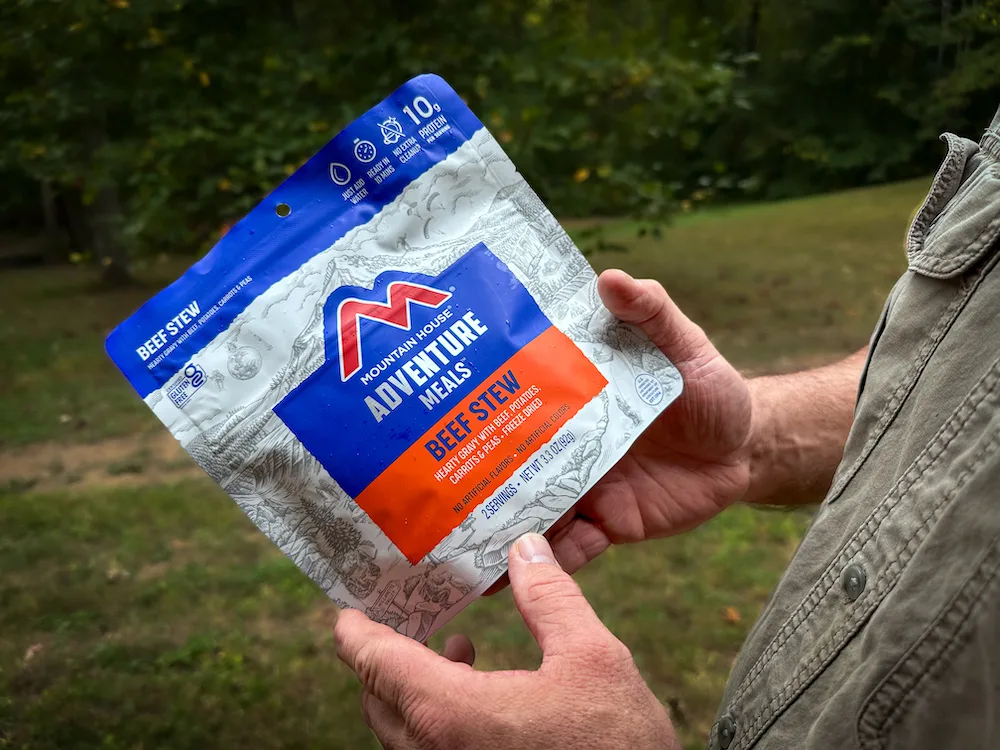
Each serving offers about 250 calories, depending on the meal. With two servings per pouch, there’s plenty for even a hearty appetite or enough to share if needed. These meals are designed to stay fresh for up to 30 years and ensure you can access quality food for decades.
Best Food Bars: Kirkland Protein Bars
Specs
Shelf Life: 5 years
Pros
Many different flavor choices
Individually packages in a case to avoid staleness when opened
Protein and carbs in one bar to maximize value to energy and avoid muscle depletion
Cons
Very difficult to eat when frozen; must be warmed if frozen
Crafted with Whey Protein Isolate as the primary protein source and fortified with high fiber while containing just 1 gram of sugar, these protein bars are perfect for daily enjoyment. Each Kirkland Signature bar offers 21 grams of high-quality protein and features real chocolate for a satisfying blend of taste and nutrition. Typically used for meal replacement and workout-focused diets, these bars conveniently meet your protein and fiber needs without compromising flavor.

In the context of disaster preparedness, these protein bars are an ideal addition to any emergency food supply. Their long shelf life, combined with their nutritional profile, makes them an excellent option for staying energized and nourished when fresh food may not be available. Lightweight and easy to store, they offer a reliable source of protein and fiber that can help maintain energy levels and support overall health during a crisis. Whether sheltering in place or on the move, these bars ensure access to essential nutrients in challenging circumstances.
Best Food Kit: Wise Company 1-Month Emergency Food Supply
Specs
Shelf Life: 25 years
Pros
Many different flavor choices
Easy to organize in bucket
Stackable and portable
Cons
Taste tests among our testers were not favorable
Wise Food Company offers many long-term food storage solutions for emergency preparedness, camping, and outdoor activities. Their products are known for convenience, offering freeze-dried meals that are easy to prepare—add water. With a focus on taste and nutrition, Wise Foods provides various meal options, including breakfast, lunch, and dinner entrees, snacks, and beverages. The meals come packaged in durable, stackable buckets or pouches designed to maintain a long shelf life, often lasting up to 25 years, making them ideal for short-term and long-term storage.
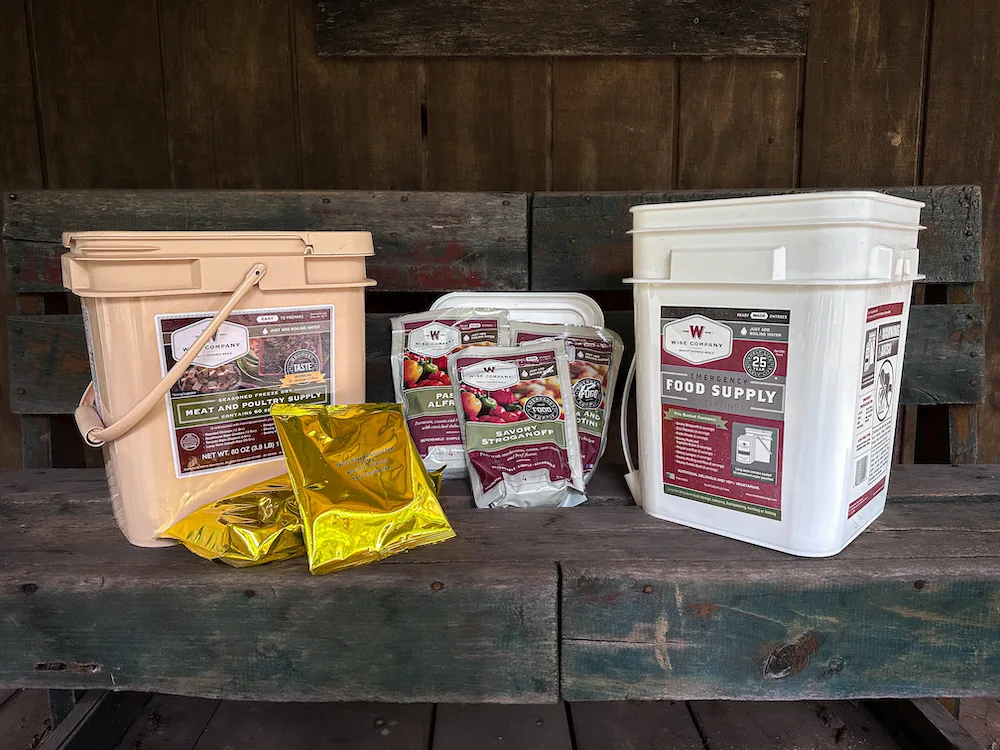
Their products cater to a wide range of dietary needs, including gluten-free and vegetarian options, ensuring everyone has access to proper nutrition during a crisis. The lightweight packaging is perfect for on-the-go situations, such as evacuations or camping trips.
Best Canned: Augason Farms
Specs
Shelf Life: 25 years
Pros
Tasty and varied food and additional options
Canned options seem to be fresher than other available options
Offer pantry products such as butter, eggs, tomato powder, pancake mix, and milk
Cons
Difficult to open without a can opener
Not easily stackable
Augason Farms is renowned for its extensive line of canned goods, which are perfect for long-term food storage and emergency preparedness. Their #10 cans are filled with freeze-dried or dehydrated foods, offering various essentials, such as fruits, vegetables, meats, grains, and dairy products. With a shelf life of up to 25 years, these canned goods are an excellent choice for those looking to build a reliable food supply for emergencies or everyday convenience. Each can is sealed for freshness and labeled with detailed preparation instructions, making incorporating these products into daily meals or survival situations easy.
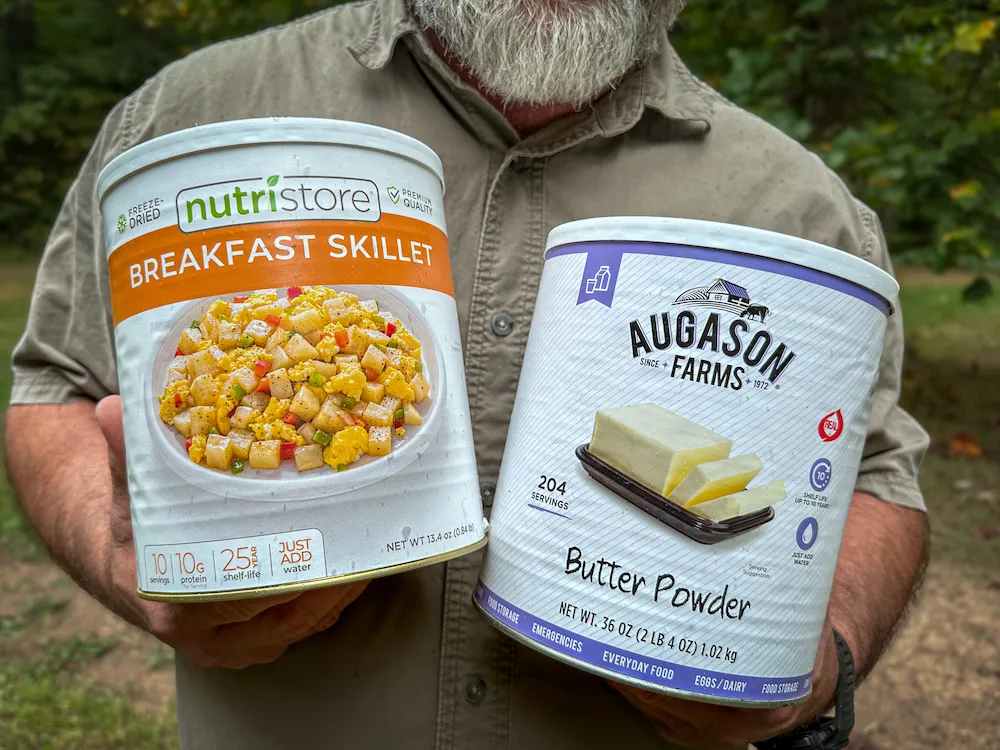
Augason Farms' canned goods are appealing because of their versatility and nutritional value. Whether you need individual ingredients like powdered eggs, instant potatoes, or freeze-dried strawberries, their products allow for flexibility in meal planning. You can use them in recipes or enjoy them independently, ensuring you have access to nutritious food options when fresh ingredients are unavailable. These canned goods are compact, easy to store, and offer large quantities, making them ideal for families, survivalists, or anyone seeking to stock up on essential food supplies that can withstand the test of time.
Best Freeze-Dried: Peak Refuel
Specs
Shelf Life: 5 years
Pros
Regularly chosen as one of the best-tasting meals available in this category by our students
Affordably priced compared to other freeze-dried options
Robust social media support and suggestions.
High value of protein, compared to many similar meals
Cons
Some survival-minded users prefer more carbs for energy than protein.
Peak Refuel is a top choice for disaster preparedness, offering high-protein, freeze-dried meals designed to keep you fueled during challenging situations. Maintaining strength and energy is essential in emergencies, and Peak Refuel meals deliver an impressive 40-50 grams of protein per serving. This high protein content ensures you get the nutrition needed to stay alert and physically capable when it matters most. Whether you're sheltering in place or need to be on the move, these meals provide the sustenance required to get through physically demanding conditions.

Beyond their nutritional value, Peak Refuel meals are incredibly convenient for disaster preparedness. Made with high-quality, non-GMO ingredients, they rehydrate quickly with hot water and are ready to eat in minutes. The lightweight, resealable pouches are easy to store and transport, making them an ideal addition to any emergency food supply. Various meal options, including breakfast scrambles and hearty dinners like chicken alfredo or beef stroganoff, offer the nutrients you need and great taste to keep morale high during tough times. Peak Refuel’s focus on protein-rich, easy-to-prepare meals makes them an excellent choice for anyone serious about disaster readiness.
Best Budget: ReadyWise Emergency Food Supply
Specs
Shelf Life: Up to 25 years
Pros
A total of 60 servings in a compact size
16 of the servings are gluten-free
Options for breakfast, lunch, and dinner
Easy to prepare
Cons
Waterproof carrying bags are more water-resistant than waterproof
ReadyWise is a leading provider of long-term food storage solutions, offering various affordable, high-quality meals that are perfect for disaster preparedness. Whether you're planning for a short-term emergency or looking to build a comprehensive survival food stockpile, ReadyWise provides convenient, easy-to-prepare options. Their freeze-dried meals only require water, making them ideal for emergencies or outdoor adventures where resources may be limited. With a focus on both taste and nutrition, ReadyWise ensures that their products not only sustain you during a crisis but also offer flavors you can enjoy.
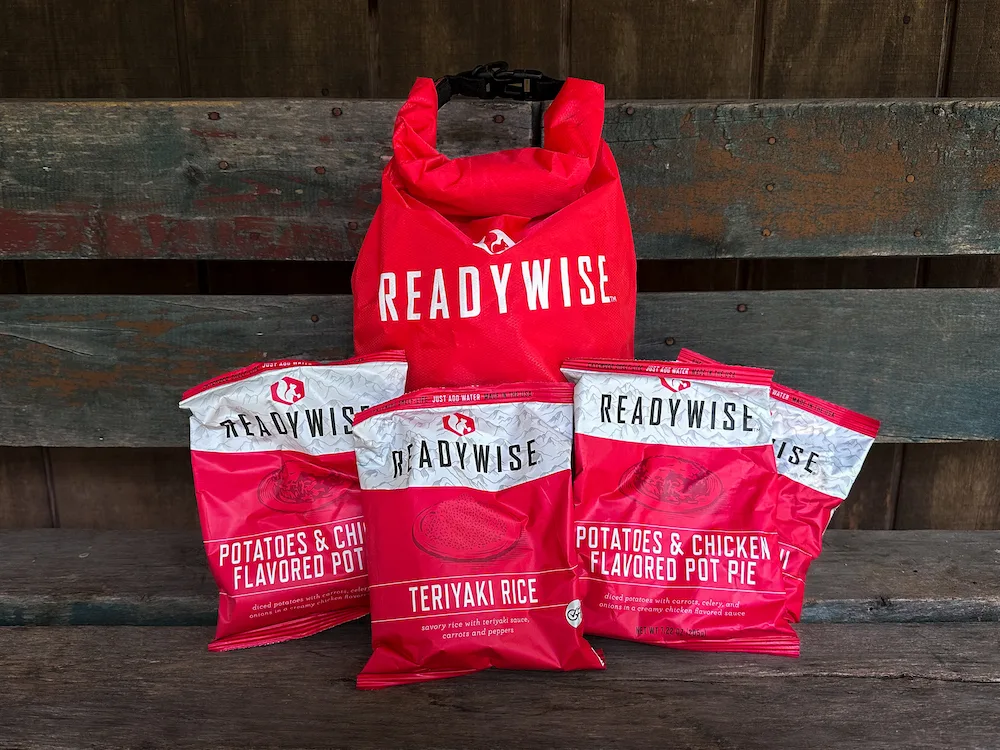
One of the standout features of ReadyWise is its budget-friendly approach, making it a top choice for those who want to prepare without breaking the bank. Despite the lower price point, ReadyWise doesn’t compromise on quality or variety, offering satisfying and nutritionally balanced meals. This combination of affordability and convenience makes ReadyWise a smart investment for families and individuals looking to secure a reliable food supply for potential emergencies. With ReadyWise, you can build your preparedness plan without overspending, ensuring peace of mind for whatever the future holds.
How We Tested Survival Food
To select the foods we tested, we received samples from a variety of reputable companies and also purchased additional products to ensure a wide range of options. With the help of our students, who have diverse tastes and preferences, we got a broad spectrum of feedback during the testing process. These foods were integrated directly into our survival and disaster readiness training courses, allowing us to evaluate their practicality, taste, and ease of preparation in real-world scenarios. This hands-on approach ensured that we tested the food's quality and performance under survival conditions.
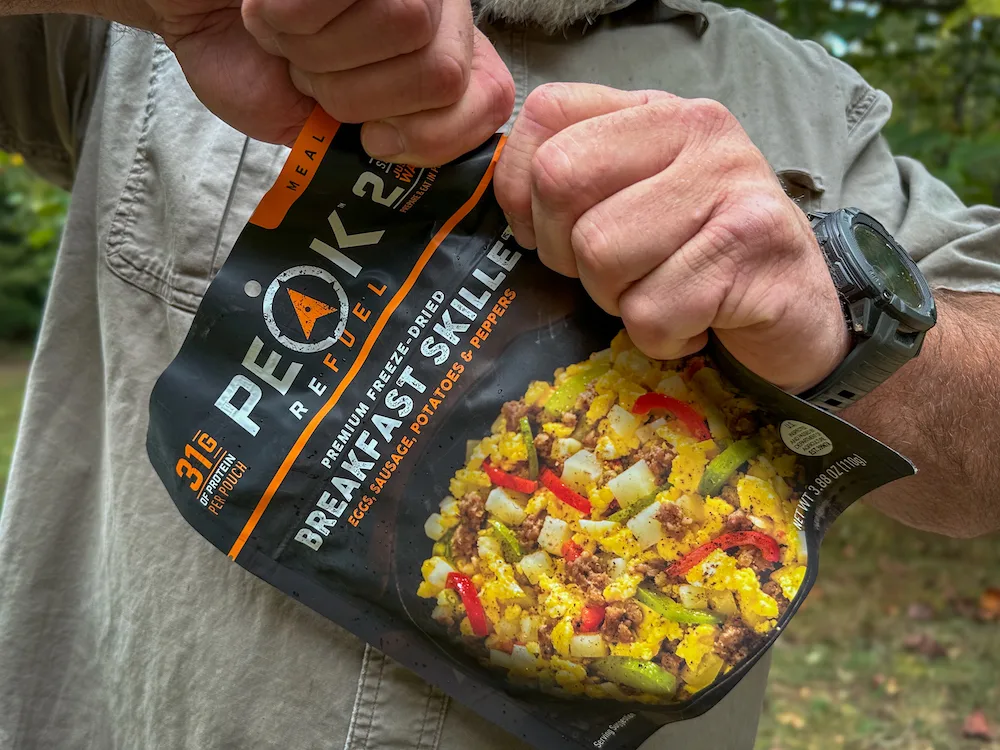
A structured approach to survival prioritization is best understood through the "Law of Threes" hierarchy. This principle outlines that our most immediate needs, in order of importance, are safety, thermoregulation, hydration, and finally, food. However, from a psychological and moral standpoint, food remains a constant desire, even though it ranks lower on essential needs.
We also took a multi-tiered approach to assessing these survival food options. I am fond of saying that “hunger is the best seasoning in the world.” That is true in the long term, but taste plays a role in the short term. When assessing them, I emphasize both taste and cost-effectiveness. After all, it makes little sense to invest in provisions that are not enjoyable to eat. In addition to these factors, I consider the following critical criteria in my recommendations:
Shelf life: These products are designed for emergency use, not daily consumption, so they must remain in storage for extended periods without spoiling. The options I’ve chosen are built to last until they’re needed.
Caloric content: Maintaining adequate energy levels is crucial during stressful situations. I’ve selected meals that provide sufficient calories to support daily physical demands.
Nutritional balance: Calories alone aren’t enough to maintain health. While nothing can fully replace fresh food, the meals I’ve recommended offer a good mix of essential vitamins and minerals. I’ve also avoided products that are excessively high in sodium or other ingredients that could be detrimental to long-term health.
Taste: Banking on our student base's wide range of taste buds, I found out what satisfied more than just my palate as a reviewer.
What To Look for in Survival Food
Taste and Palatability
One of the most overlooked factors when choosing survival food is whether or not you enjoy eating it. Taste, texture, and how the food agrees with your digestive system are essential. While it’s easy to focus on stockpiling a large quantity of food, if you don’t like it, you’re essentially wasting money. Some may argue that you’ll eat anything in extreme hunger, but right now, you have the luxury of selecting food you’ll enjoy. Regularly incorporating these meals into your current diet helps rotate stock and prepares your taste buds for when disaster strikes. As the saying goes, "We do not rise to the occasion; we default to our level of training." Why not start training your palate now?
Cost
Cost is another critical consideration when building a survival food supply. Most people must budget carefully, so simultaneously making large purchases may be impossible. A gradual approach works well for many, where small amounts are bought over time as the budget allows. This makes the process more manageable and helps you steadily grow your stockpile without straining your finances. If you face resistance from family members about spending on survival food, consider framing it as an insurance policy—something you invest in for peace of mind in case of a worst-case scenario.
Storage Space
Storage space can be a real challenge for those living in smaller spaces like apartments, condos, or tiny homes. It's crucial to make the most of your space by considering the size of the packaging and the number of servings per product. This ensures you get the most food stored in the least space. Carefully evaluating your storage setup and choosing compact, efficient products can help maximize your shelf space and investment.
FAQs
Q: How do you store survival food?
Storing survival food is best done in conditions that are dark, cool, and dry. These three factors will work together to slow down the degradation of the food. A closet in a spare bedroom, for example, might be a great location. A damp basement, perhaps not so much.
Q: How much food do you need?
Most survival situations tend to last around 72 hours. However, in recent years, many emergencies have extended beyond that timeframe, and with global uncertainty, the possibility of more prolonged events is not just possible but increasingly likely. As a precaution, I recommend planning for at least one month's worth of food for everyone in your household, ensuring you’re prepared for longer-term scenarios.
Q: What else do you need in a survival situation?
As previously mentioned, our primary needs follow a specific order: safety, thermoregulation, water, and food. For safety, ensure you have the tools necessary to protect yourself from both environmental threats and potential harm from others. This includes items to help you see in low-light situations and defend yourself if needed. Thermoregulation involves staying warm in cold weather and cool in hot conditions, so be sure to have adequate clothing and supplies to maintain comfort for at least one month without access to utilities.
Water is an invaluable resource, and it’s crucial to have both filtration and purification methods to protect against bacterial and viral contaminants. In addition to these essentials, it’s wise to have signaling tools like bright-colored items, flashlights, and whistles to help attract attention if necessary.
Final Thoughts
Choosing survival food to keep on hand for emergencies requires a little homework and research. You shouldn’t buy several cases of something simply because the package looks enticing. Base your decision on facts, including budget and the quality of the food. Ease of preparation is also a factor, of course. In an emergency, you may not have ready access to things like stovetops or microwave ovens. Stick with things that require a minimal amount of preparation. Hopefully, you’ll never be in a situation where you must rely on survival food, but you’ll be glad you have it should the unthinkable occur.
Why Trust Us
For more than 125 years, Field & Stream has been providing readers with honest and authentic coverage of outdoor gear. Our writers and editors eat, sleep, and breathe the outdoors, and that passion comes through in our product reviews. You can count on F&S to keep you up to date on the best new gear. And when we write about a product—whether it’s a bass lure or a backpack—we cover the good and the bad, so you know exactly what to expect before you decide to make a purchase.

